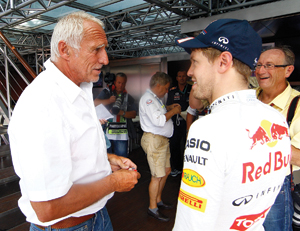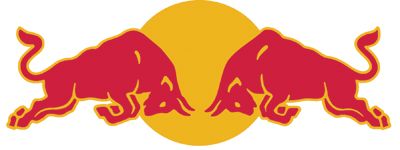Austrian-based Red Bull has evolved from an energy drink producer to a lifestyle brand. The company now owns everything from a TV station, music label and print magazines, to Formula One teams and football and hockey franchises.
It’s a rise tightly connected to the sports world. When Red Bull founder Dietrich Mateschitz launched the energy drink in 1987, it was the company’s connection to action sports that put Red Bull on the map.
 |
Red Bull founder Dietrich Mateschitz (left) has used high-profile deals such as the Red Bull Formula One team and driver Sebastian Vettel to put the energy drink brand in a league of its own.
Photo by: Getty Images |
“The focus on action sports during Red Bull’s early years was Mateschitz’s talent to make a virtue out of necessity,” said Austrian journalist Wolfgang Fürweger, who wrote the book “The Red Bull Story — The Unbelievable Success of Dietrich Mateschitz.” “Red Bull’s ambitious marketing strategy of displaying the brand in an omnipresent way was simply not affordable in traditional sports such as football and motorsports at the beginning.”
It was the young generation of the ’80s that helped sports such as snowboarding, skateboarding and paragliding gain recognition. “Mateschitz perfectly understood how to cater to the generation of yuppies in the late ’80s, which also wanted to differentiate itself from the older generation by what it drinks,” Fürweger said.
Red Bull is still highly involved in action sports, but its growth has allowed it to move into mainstream sports. A Red Bull spokeswoman said the company now supports more than 600 athletes in 160-plus disciplines globally.
While expanding its global reach in the sports world, the company has also continued to diversify its business portfolio. In 2007, Red Bull established a global media company called Red Bull Media House.
“[The Media House was founded] to create authentic entertainment and build a secondary sustainable business,” the Red Bull spokeswoman said. “We are well positioned to maximize the new model in today’s media landscape because we own/control content and platforms, which gives us complete autonomy to distribute and monetize globally.”
She added, “In its 27-year history, Red Bull has gone from being sold in one country to more than 165 countries today. The growth has been incredible, but we’ve done it step by step to build a loyal consumer base.”
This loyal consumer base has been told that Red Bull “gives you wings,” enabling them to live out their dreams. It’s a slogan that helped the company generate close to the $6.5 billion in global revenue in 2012 while selling more than 5.2 billion cans of its energy drink, according to Forbes.
To understand Red Bull’s enormous expansion and growth in less than three decades, it is important to look at
 |
Red Bull founded the X-Fighters World Tour in 2001.
Photo by: Getty Images |
company’s mission statement. In Austria’s commercial register, where Red Bull is listed, companies have to describe their business purpose. The energy drink company’s listing reads: “Red Bull’s objective is the marketing of the brand Red Bull.” It shows that from its inception, Red Bull was about much more than selling energy drinks.
With this in mind, Red Bull is already looking for new business ventures.
“The company tries to cover every aspect of its customers’ life, from their sports and leisure behavior to media consumption,” Fürweger said. “It likely will create its own radio station and daily newspaper in the near future. However, its most current project seems to be the development and launch of a worldwide TV network.”
Red Bull now owns a television station (Servus TV) in Austria that features programming such as documentaries, news broadcasts, live sports, talk shows and magazine shows targeted at German-speaking viewers in Austria, Germany and Switzerland.
Content for the proposed global network would come from Red Bull Media House, which is already producing numerous programs and features around the company’s athletes and events. The company spokesperson declined to discuss plans for the network.
The reluctance of Red Bull and Mateschitz to talk to the media has been well documented. Fürweger said, after an unflattering article was written about Mateschitz in Austrian celebrity magazine Seitenblicke, Mateschitz bought the magazine “with the purpose of not appearing in it anymore.” He added, “It is certainly also the fear of not being able to control everything. Red Bull tries to control everything that is published and written about Red Bull. And the only way to accomplish it is to almost completely shut off communication.”
Red Bull’s energy drink division has attracted a number of strong competitors. In reaction to brands such as Monster, Rockstar and 5-Hour Energy, the company introduced three new flavors and energy shots to its product portfolio in recent years.
Despite this strong competition, especially from Monster in the U.S., Red Bull has kept its dominant position on the worldwide energy drink market. According to research company Euromonitor International, Red Bull in 2012 reported a net sales growth of 15.9 percent with strong sales growth in South Africa (+52 percent), Japan (+51 percent), Saudi Arabia (+38 percent), France (+21 percent), the U.S. (+17 percent) and Germany (+14 percent).
As for Red Bull’s next conquests, Fürweger said, “In its core business, Red Bull wants to eliminate the last remaining white spots on the globe. There is certainly some potential in India, China, South Africa and Brazil, the world’s most populous countries, where Red Bull has not yet the same reach it has in other nations.”
HJ Mai writes for sister publication SportsBusiness Daily Global.
Sizing up the competition
■ Monster Energy
Red Bull’s biggest competitor is California-based energy drink Monster Energy. The similarities between Monster and Red Bull, especially in the area of marketing, are striking. Both companies focus their marketing on action sports, motorsports and music to target a young, predominantly male demographic.
In just a little more than a decade, Monster has become the undisputed No. 2 in the U.S. energy drink market and has built its annual sales to $2.4 billion and net income to $340 million. Through sponsorships with the Mercedes Formula One team and several MotoGP drivers, Monster has also increased its international business, which now accounts for 20 percent of its total sales.
■ PepsiCo
Despite not being exclusively an energy drink, PepsiCo’s Mountain Dew has embraced action sports and is a strong competitor of Red Bull. The soft drink brand was one of the first sponsors of the X Games and has continued to support competitions and individual athletes. In 2005, the brand developed the Dew Tour with Alli, a division of NBC Sports, which was born out of insights taken directly from action sports athletes and fans. A Mountain Dew spokesperson said, “Together, we developed an idea that carved out a role for Mountain Dew as co-creator vs. sponsor.”
HQs stay on the DL
Red Bull is known for flashing its logo, slogan, products, athletes and musicians in a prolific way at events. But the company’s headquarters in Fuschl am See near Salzburg, Austria, lacks those flashy trademark features. The plain, dark-colored complex consists of several buildings with plain glass fronts. Not a single symbol at its headquarters would identify the company. Asked why Red Bull is so secretive, author Wolfgang Fürweger, who wrote a book about Red Bull, believes it’s a character trait of Red Bull founder Dietrich Mateschitz, who doesn’t want people to know and write about his personal life. “On the other hand, it is certainly also part of [Red Bull’s] marketing strategy because everything secretive becomes, in turn, intriguing.”
Red Bull timeline
1987
■ Red Bull launches energy drink in Austria.
■ Signs one-year shirt sponsorship deal with Austrian hockey club EC Salzburg.
1989
■ Former Austrian F1 driver Gerhard Berger becomes the first motorsports athlete to be sponsored by Red Bull.
1992
■ Hosts its first “Flugtag” (Flight Day) event in Vienna.
1994
■ Windsurfers Bjorn Dunkerbeck (Netherlands) and Robby Naish (USA) become the first international athletes to join the Red Bull roster.
1995
■ Enters 10-year partnership with the Sauber F1 Team and purchases majority share in the team.
2000
■ Launches its product in the Middle East.
■ Returns as sponsor and naming-rights partner of EC Salzburg.
2001
■ Founds new sport called Red Bull Crashed Ice.
■ Founds Red Bull X-Fighters World Tour for freestyle motocross.
2003
■ Founds international air race series called Red Bull Air Race.
2004
■ Buys F1 team Jaguar Racing, owned by Ford Motor Co.; rebrands it Red Bull Racing.
■ After EC Salzburg returns to Austria’s top-flight hockey league, Erste Bank Eishockey Liga, Red Bull takes over complete ownership of the club and rebrands it EC Red Bull Salzburg.
2005
■ Takes over Austrian football Bundesliga club SV Austria Salzburg and rebrands it Red Bull Salzburg.
■n Buys F1 team Minardi and strikes 50/50 joint-ownership deal with former Austrian F1 driver Gerhard Berger. It rebrands the Italian-based team to Scuderia Toro Rosso, which is Italian for “Stable Red Bull.”
2006
■ Founds NASCAR Sprint Cup team know as Team Red Bull.
■ Buys Major League Soccer franchise New York/New Jersey MetroStars from AEG and rebrands it New York Red Bulls.
2007
■ Founds its own music label, Red Bull Records.
2008
■ Buys Berger’s share of the team and becomes sole owner of Scuderia Toro Rosso.
2009
■ Buys license of German fifth division football club SSV Markranstädt and founds RasenBallsport Leipzig, commonly known as RB Leipzig.
2011
■ NASCAR Sprint Cup Team Red Bull ceases operations due to lack of on-track success.
2012
■ Signs shirt sponsorship and naming-rights deal with German Hockey League club EHC Munich.
2013
■ Takes over ownership of EHC Munich and renames team EHC Red Bull Munich.






